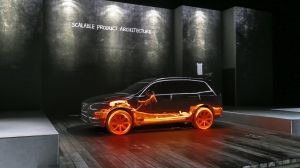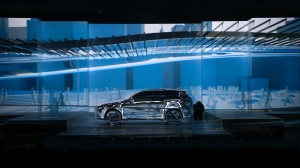- When Volvo unveiled the XC90 in Stockholm late last year it tasked Lightland AB with projection mapping the rotating vehicle for the automaker’s keynote presentation to the press. Working with video consultant studio BAJT, they relied on nine media servers from d3 Technologies to map the new car with blended real-time imagery from three different projectors, with another twelve projectors for all and floor scenery.
One of the three projection angles used during the Volvo XC90 presentation.
The visuals supported the speakers and explained new design elements, technical features and safety-related aspects of the XC90 in a fun and efficient way. A+A Communications in Gothenburg, Sweden produced the show; content was created by Edithouse and Lightland was the technical designer and supplier. Dandelion & Burdock did the template unwrapping of the car and the scenery models and installed the project onsite.
The team deployed nine d3 media servers. “Since we were projecting onto a rotating car from three different projector positions we needed a system that handled real-time mapping onto a moving object and at the same time dynamically recalculated the blend among the projectors,” Studio BAJT’s David Bajt explains.
In order to project onto the rotating car, the rotation of the car’s turntable was encoded and sent to d3 as an Art-Net signal. “When the car’s platform rotated, so did the virtual one in d3,” says Bajt. “Using d3’s projection tools, such as QuickCal and Dynamic Blend, the car could therefore be mapped in real-time.”
He notes that the presentation marked the first time that Dynamic Blend was used on a project. “We got great support from d3 Technologies,” Bajt says. Bajt also gives kudos to the media server’s “superior ability to previsualize and program the show prior to going onsite.”
That gave him the opportunity to “test the technical requirements – lens options, number of projectors, projector positions – during the early days of production,” he says. “This was crucial. Lightland technical manager Joakim Rydholm and I worked on this months before the show happened. We also used d3’s visualizer to decide the point of view for some of the more three-dimensional content, such as X-ray
and see-through effects.”

Another angle showcasing the visualization work done facilitated by d3 Technologies.
Bajt notes that “the car projection wasn’t the only projection element in the show: The rest of the set had to mapped too – and quickly. Using d3’s QuickCal feature for swift projector calibration we were able to accomplish this is just a few hours.”He also liked d3’s MultiEdit feature, which enabled laptops to join the d3 network and map the projectors far from the control position. “Using the laptops we managed to sit on stage and do all the mapping while the timeline programming team worked on the creative aspects of the show,” Bajt explains. “The parallel workflow was a killer! And d3 performed just great for the whole show.”










